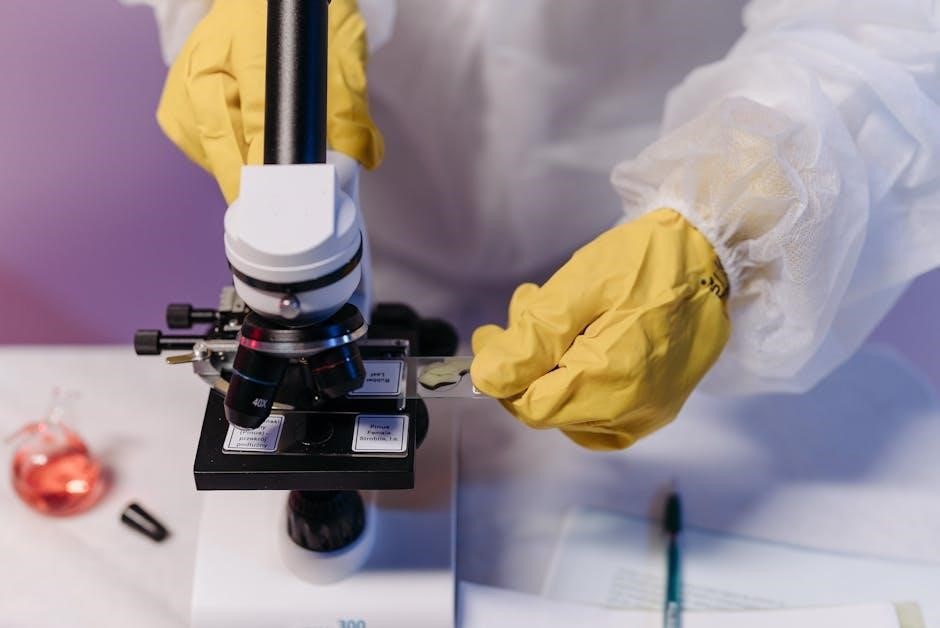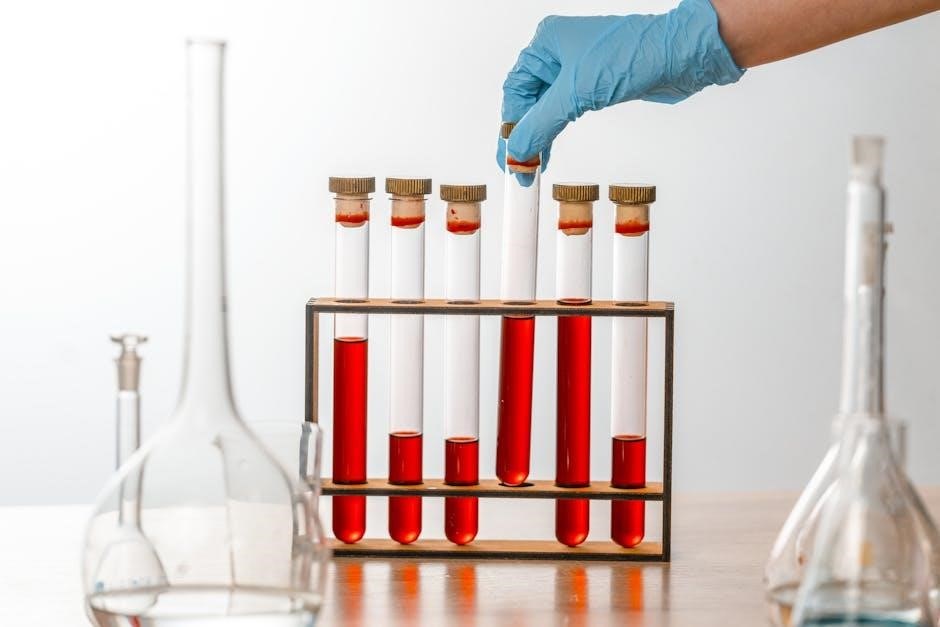Safety in the Organic Chemistry Laboratory
Safety is critical in the organic chemistry lab. Familiarize yourself with emergency procedures, use personal protective equipment, and handle hazardous chemicals with care. Proper ventilation and waste disposal are essential.
1.1. Emergency Procedures and Equipment
In the organic chemistry laboratory, emergency preparedness is essential. Familiarize yourself with the location of emergency exits, fire extinguishers, and spill kits. Know the proper use of eyewashes and safety showers.
Fire extinguishers should be checked regularly, and personnel must know how to operate them. Spill kits are designed to contain and neutralize hazardous chemical spills.
First aid kits should be readily accessible, and lab personnel must be trained in basic first aid. Regular evacuation drills ensure preparedness in case of emergencies.
Report all incidents promptly to the lab supervisor. Stay calm and follow established protocols to minimize risks and ensure a safe environment. Regular training updates are crucial;
1.2. Personal Protective Equipment (PPE)
Personal Protective Equipment (PPE) is vital in an organic chemistry laboratory to safeguard against chemical exposures and physical hazards. Essential PPE includes lab coats, gloves, goggles, and closed-toe shoes. Lab coats should be made of durable, chemical-resistant materials like cotton or synthetic blends. Gloves, such as nitrile or latex, prevent skin contact with hazardous substances. Goggles or safety glasses with a face shield protect eyes from splashes.

- Lab coats should be worn at all times in the lab.
- Gloves must be inspected for tears before use and replaced regularly.
- Goggles should fit snugly to ensure proper protection.
- Closed-toe, non-slip shoes are mandatory to prevent foot injuries.
Additional PPE, such as face shields, may be required for high-risk procedures. Always inspect PPE before use and follow lab protocols for proper handling and disposal.
1.3. Handling Hazardous Chemicals

Handling hazardous chemicals in an organic chemistry lab requires strict adherence to safety protocols. Always read and understand the Safety Data Sheet (SDS) before working with any chemical. Wear appropriate PPE and ensure the work area is well-ventilated. Flammable or corrosive chemicals should be stored in designated cabinets, away from incompatible substances. Use secondary containment, such as trays, to prevent spills from spreading. Avoid skin contact and inhalation of fumes. When transferring chemicals, use glassware or equipment that resists chemical corrosion. Dispose of hazardous waste in labeled containers according to lab guidelines. Never mix chemicals without prior knowledge of their compatibility. Follow proper decontamination procedures after handling hazardous materials.

Basic Laboratory Techniques in Organic Chemistry
Mastering fundamental lab techniques is essential for organic chemistry. Purification, isolation, and separation methods are critical for preparing and analyzing organic compounds; Crystallization, distillation, extraction, and chromatography are commonly used to ensure purity and precision in experiments. These techniques require precision, patience, and proper use of glassware and equipment to achieve accurate results. Understanding these methods is vital for successful organic synthesis and characterization.
2.1. Purification and Isolation of Organic Compounds

Purification and isolation are critical steps in organic chemistry to obtain pure compounds for analysis and further reactions. Common methods include crystallization, distillation, and extraction. Crystallization involves dissolving a compound in hot solvent and cooling it slowly to form pure crystals. Distillation separates substances based on boiling points, ideal for liquids. Extraction uses solubility differences between immiscible solvents to isolate compounds. Filtration is often used to separate solids from liquids. These techniques ensure impurities are removed, preventing interference in subsequent reactions. Proper execution of these methods is essential for achieving high purity, which is crucial for accurate characterization and successful synthesis. Without effective purification, experimental results may be compromised, making these skills fundamental for any organic chemist.
2.2. Crystallization and Distillation
Crystallization and distillation are essential techniques for purifying organic compounds. Crystallization involves dissolving a compound in a hot solvent and cooling it slowly to form pure crystals, separating it from impurities. This method is ideal for solids. Distillation separates substances based on differences in boiling points, making it suitable for liquids. Simple distillation is used for pure substances, while fractional distillation separates mixtures with similar boiling points. Vacuum distillation is employed for compounds that decompose at high temperatures. Proper setup and monitoring are crucial for both methods to ensure purity and yield. These techniques are fundamental in organic chemistry for obtaining pure compounds for further analysis or reactions, ensuring accurate results and efficient processes.
2.3. Extraction and Chromatography
Extraction and chromatography are critical techniques for separating and purifying organic compounds. Extraction involves transferring a compound from one solvent to another based on solubility and density differences. Liquid-liquid extraction is commonly used, while solid-liquid extraction involves leaching compounds from solids. Chromatography separates mixtures based on the distribution of components between a stationary phase and a mobile phase. Common methods include paper chromatography, thin-layer chromatography (TLC), and column chromatography. TLC is widely used for quick analyses, while column chromatography provides higher resolution for larger-scale separations. These methods are invaluable in organic chemistry for isolating pure compounds from complex mixtures, enabling further characterization and synthesis. Proper technique ensures efficient separation and high purity of the desired compound.

Synthesis Methods in Organic Chemistry
Synthesis methods in organic chemistry involve constructing complex molecules through controlled chemical reactions. Common techniques include elimination, addition, and substitution reactions, enabling the formation of diverse organic compounds.
3.1. SN1 and SN2 Reactions
SN1 and SN2 reactions are fundamental nucleophilic substitution mechanisms in organic chemistry. SN1 proceeds via a two-step process, involving the formation of a carbocation intermediate, while SN2 occurs in a single step with a backside attack by the nucleophile. SN1 reactions are favored in polar, protic solvents and typically involve tertiary substrates due to the stability of the carbocation. In contrast, SN2 reactions prefer polar, aprotic solvents and are more common with primary substrates due to less steric hindrance. Understanding these mechanisms is crucial for predicting reaction outcomes and designing synthetic pathways in the organic chemistry laboratory.
3.2. Elimination Reactions
Elimination reactions involve the removal of atoms or groups from a molecule, resulting in the formation of a double bond or triple bond. These reactions are typically facilitated by heat, strong bases, or acidic conditions. E1 and E2 mechanisms are the primary pathways for elimination. E1 proceeds via a two-step process, involving carbocation formation, while E2 occurs in a single concerted step. The choice of mechanism depends on the substrate and reaction conditions. Tertiary substrates favor E1 due to stable carbocations, whereas primary substrates prefer E2 due to less steric hindrance. Understanding these mechanisms is essential for controlling reaction outcomes and synthesizing alkenes or alkynes in the organic chemistry laboratory. Zaitsev’s rule predicts the major product based on the stability of the resulting alkene.
3.3. Addition Reactions
Addition reactions are fundamental processes in organic chemistry where two or more molecules combine to form a single product. These reactions often involve the breaking of double or triple bonds, with the addition of atoms, groups, or molecules across these bonds. Common types include electrophilic addition (e;g., addition of HCl to alkenes), nucleophilic addition (e.g., addition of Grignard reagents to carbonyl compounds), and radical addition. The stereochemistry of the reaction is critical, as it determines the product’s structure. Reagents like H2, H2O, and BH3 are commonly used. Addition reactions are essential for synthesizing complex molecules and understanding reaction mechanisms. They are widely used in both laboratory and industrial settings to create alkanes, alcohols, and other functionalized compounds.

Characterization Techniques
Characterization techniques in organic chemistry are essential for identifying compounds, determining their structures, and ensuring purity. These methods include various spectroscopic and chromatographic analyses, enabling precise molecular identification and verification of reaction outcomes.
4.1. Infrared Spectroscopy (IR)
Infrared spectroscopy (IR) is a powerful tool for identifying organic compounds by analyzing molecular vibrations. It provides information about functional groups, such as hydroxyl (-OH), carbonyl (C=O), and methyl (C-H) groups. IR spectra are obtained by measuring the absorption of infrared radiation by a sample, typically prepared as a solid (KBr pellet) or liquid (neat or ATR). Key absorption bands correspond to specific bond vibrations, enabling structural elucidation. Students use IR to confirm reaction outcomes, identify unknown compounds, and monitor functional group transformations. Proper interpretation requires comparing spectra to reference databases or known standards. IR is quick, non-destructive, and essential for verifying the success of organic syntheses.

4.2. Nuclear Magnetic Resonance (NMR)
Nuclear Magnetic Resonance (NMR) spectroscopy is a key analytical technique in organic chemistry for determining molecular structure. It provides detailed information about the environment of nuclei, particularly protons (1H NMR) and carbons (13C NMR). By analyzing splitting patterns, integration, and chemical shifts, students can identify neighboring groups, functional groups, and molecular symmetry. NMR is non-destructive and highly informative for confirming reaction products, identifying unknown compounds, and studying dynamic processes. Proper interpretation requires understanding solvent effects, peak splitting, and coupling constants. Modern NMR spectrometers are essential tools in organic chemistry labs, enabling precise structural elucidation and verification of synthetic outcomes.
4.3. Mass Spectrometry (MS)
Mass Spectrometry (MS) is a powerful analytical technique used to determine the molecular weight, composition, and structure of organic compounds. It works by ionizing molecules and measuring the mass-to-charge ratio (m/z) of charged particles. In organic chemistry labs, MS is essential for identifying unknown compounds, confirming synthetic products, and analyzing mixtures. Key features include high sensitivity and the ability to detect trace amounts. The mass spectrum provides information about molecular weight, fragmentation patterns, and isotopic composition, aiding in structural elucidation. Students learn to interpret spectra by identifying the molecular ion peak, base peak, and fragmentation clues. MS is a cornerstone in modern analytical chemistry, enabling precise characterization of organic molecules and verifying reaction outcomes.

Green Chemistry Practices
Green chemistry practices focus on designing chemical processes that minimize environmental impact through sustainable methods and safer alternatives in organic synthesis and production.
5.1. Minimizing Waste in Organic Synthesis
Minimizing waste in organic synthesis is a cornerstone of green chemistry, focusing on reducing the environmental footprint of chemical processes. This involves optimizing reaction conditions to maximize yields and minimize by-products. Techniques such as catalytic reactions, which reduce the need for stoichiometric reagents, play a key role. Selective reagents and atom-economical reactions are prioritized to lower waste generation. Additionally, solvent reduction strategies, such as solvent-free reactions or the use of alternative solvents like ionic liquids, contribute significantly. Efficient purification methods, like recrystallization or distillation, help recover valuable materials. Finally, waste recycling programs ensure proper disposal and reuse of chemical by-products, promoting sustainability in the laboratory setting.
5.2. Solvent-Free Reactions
Solvent-free reactions are a key strategy in green chemistry, aiming to reduce the environmental impact of organic synthesis. By eliminating solvents, these reactions minimize waste, reduce toxicity, and lower the risk of contamination. Many organic transformations can be performed under solvent-free conditions, such as using neat reactants or employing mechanical methods like grinding in a mortar and pestle. Advanced techniques, including microwave-assisted or ultrasound-mediated reactions, often thrive without solvents, enhancing reaction rates and yields. Solvent-free approaches also simplify purification steps, as fewer by-products are generated. This method aligns with sustainable practices, making organic synthesis more efficient and environmentally friendly while maintaining chemical efficacy.
5.3. Catalytic Methods
Catalytic methods are central to green chemistry, enabling efficient and sustainable organic synthesis. Catalysts, which accelerate reactions without being consumed, reduce the need for excess reactants and energy. Heterogeneous catalysis, where the catalyst exists in a different phase than the reactants, is particularly advantageous as it allows for easy separation and reuse. Homogeneous catalysis, though more challenging to recover, offers high selectivity and efficiency. Biocatalysts, such as enzymes, provide environmentally friendly alternatives, operating under mild conditions. Catalytic methods minimize waste, lower reaction temperatures, and enhance atom economy, making them indispensable for eco-friendly synthesis. Their implementation aligns with green chemistry principles, reducing environmental impact while maintaining high productivity.

Resources for Organic Chemistry Students
Organic chemistry students benefit from textbooks, online platforms, and interactive tools, providing foundational knowledge and practical skills for successful experimentation and learning in the laboratory setting.
6.1. Lab Manuals and Guides
Lab manuals and guides are essential resources for organic chemistry students, providing detailed procedures, safety protocols, and experimental techniques. These manuals often include step-by-step instructions for common organic reactions, purification methods, and analytical techniques. They also cover hazard assessments, waste disposal, and emergency procedures, ensuring safe laboratory practices. Many lab manuals, such as the Organic Chemistry Lab Manual by Jerry R. Mohrig, are tailored for undergraduate students, offering clear explanations and practical tips. Additionally, some manuals incorporate green chemistry principles, emphasizing eco-friendly practices. These resources help students transition from theoretical knowledge to hands-on experimentation, making them indispensable for successful laboratory work and preparation for professional challenges in organic chemistry.
6.2. Online Databases and Tools (e.g., Reaxys, ChemDraw)
Online databases and tools are invaluable for organic chemistry students, providing access to comprehensive chemical information and simplifying lab workflows. Reaxys, for instance, offers extensive databases of chemical reactions, properties, and literature, aiding in synthesis planning and compound identification. ChemDraw enables the creation of chemical structures, reactions, and reports, which are essential for documenting experiments. Other tools like SciFinder and PubChem provide access to vast repositories of chemical data, while Jmol and PyMOL allow for molecular visualization. These resources streamline research, enhance productivity, and support both theoretical and practical learning in organic chemistry, making them indispensable for students and professionals alike.
6.3. Study Tips and Exam Preparation
Mastering organic chemistry requires consistent effort and effective study strategies. Start by understanding fundamental concepts like reaction mechanisms and molecular structures. Regularly practice solving problems to improve your ability to identify patterns and predict outcomes. Use flashcards to memorize key reactions, reagents, and functional groups. Group study sessions can help clarify doubts and deepen understanding. Review lab experiments and relate them to theoretical concepts; Create a study schedule and focus on high-yield topics like substitution, elimination, and addition reactions. Utilize active learning techniques, such as drawing structures and mechanisms, to reinforce memory. Stay organized, and ensure adequate rest before exams. These strategies will help you excel in both lab work and theoretical assessments.



